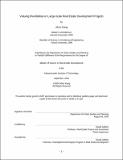| dc.contributor.advisor | David Geltner. | en_US |
| dc.contributor.author | Kang, Jihun, 1971- | en_US |
| dc.contributor.other | Massachusetts Institute of Technology. Dept. of Urban Studies and Planning. | en_US |
| dc.date.accessioned | 2005-09-06T19:54:30Z | |
| dc.date.available | 2005-09-06T19:54:30Z | |
| dc.date.copyright | 2004 | en_US |
| dc.date.issued | 2004 | en_US |
| dc.identifier.uri | http://hdl.handle.net/1721.1/26739 | |
| dc.description | Thesis (S.M.)--Massachusetts Institute of Technology, Dept. of Urban Studies and Planning, 2004. | en_US |
| dc.description | This electronic version was submitted by the student author. The certified thesis is available in the Institute Archives and Special Collections. | en_US |
| dc.description | Includes bibliographical references (leaves 147-150). | en_US |
| dc.description.abstract | This thesis aims to develop a set of strategic tools for real estate development projects. The conventional tools such as the Discounted Cash Flow (DCF) method fail to incorporate dynamics of real estate development processes. As a result, their application to real world situation is quite limited. Two methods are introduced to deal with this inadequacy of the DCF method. Decision Tree Analysis (DTA) employs a management science approach to analyze flexibilities and corresponding strategies from management decision making perspective. Real Options Analysis (ROA) aims to apply theories of valuing financial derivatives to real assets and it allows investors to quantitatively analyze flexibilities. Each technique has advantages and shortcomings and should only be used for appropriate situations. DTA is suited for analyses of project specific risks that are not directly related to the overall market. ROA is a superior tool when risks are originated from the uncertainties of markets. Applying both tools in practice requires rather simplified assumptions, and it is crucial to understand them to make the analyses meaningful. The thesis finds that incorporating flexibilities in decision making into an analysis is especially important for large-scale and multi-phase projects. The DCF method treats the later phase projects as if they are fully committed at the present time. This assumption of full commitment is rarely the case in the real world practice, and as a result, the DCF method systematically undervalues future phases in multi-phase projects. The case study of New Songdo City reveals that the value of flexibility is a critical factor for the analyses of large scale projects, especially when there is a lot of market uncertainties involved. Based on the conventional DCF method, New Songdo City has a hugely negative NPV and should not be pursued. However, the ROA and the DTA approaches show that it has a potential for creating enormous value by incorporating flexibilities of the project. | en_US |
| dc.description.statementofresponsibility | by Jihun Kang. | en_US |
| dc.format.extent | 150 leaves | en_US |
| dc.format.extent | 7594896 bytes | |
| dc.format.extent | 7789581 bytes | |
| dc.format.mimetype | application/pdf | |
| dc.format.mimetype | application/pdf | |
| dc.language.iso | en_US | |
| dc.publisher | Massachusetts Institute of Technology | en_US |
| dc.rights | M.I.T. theses are protected by copyright. They may be viewed from this source for any purpose, but reproduction or distribution in any format is prohibited without written permission. See provided URL for inquiries about permission. | en_US |
| dc.rights.uri | http://dspace.mit.edu/handle/1721.1/7582 | |
| dc.subject | Urban Studies and Planning. | en_US |
| dc.title | Valuing flexibilities in large-scale real estate development projects | en_US |
| dc.type | Thesis | en_US |
| dc.description.degree | S.M. | en_US |
| dc.contributor.department | Massachusetts Institute of Technology. Department of Urban Studies and Planning | |
| dc.identifier.oclc | 59820836 | en_US |
